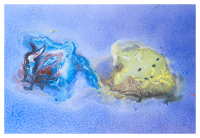Speaker
Vladimir Vechernin
(St. Petersburg State University (RU))
Description
The approach relies on a microscopic treatment of cumulative phenomena based on perturbative QCD calculations of the corresponding quark diagrams near the thresholds [1]. This enables to find the asymptotic behavior of the structure functions of nuclear fluctons – the dense drops of nuclear matter in nuclei composed of a few nucleons. As a result, in the framework of the approach the nuclear structure function of the DIS process from nuclei and the yield of charged particles in the cumulative region were calculated [2]. It was shown [3] that the approach enables to describe the increase of the mean transverse momentum of the produced pions with the growth of their cumulativity $x$. It was also found [4] that in the case of cumulative proton production the mechanism of quark coalescence (coherent quark fusion) dominates over the production by fragmentation of one fast cumulative parton. Later it was confirmed in STAR and PHENIX experimental studies of azimuthal flows at RHIC [5-7] that the production of hadrons with transverse momenta upto a few GeV/c are well described by the mechanism of the coalescence (recombination) of the valence quarks.
In present study we focus on the calculations of the transverse momentum dependence of cumulative pions and protons spectra in the framework of the Quark Coherent Coalescence (QCC) model [4]. The results are shown in Fig.1. We see that the model enables to describe the transverse momentum dependence of the yields of cumulative pions and protons at different values of their cumulativity $x$ with the only parameter – the constituent quark mass, taken to be equal 300 MeV.
The author thanks Saint-Petersburg State University for the research grant 11.38.197.2014 and the RFFI for the grant 12-02-00356-a.
References
1. M.A. Braun, V.V. Vechernin, Nucl. Phys. B 427, 614 (1994).
2. M.A. Braun, V.V. Vechernin, Physics of Atomic Nuclei 60, 432 (1997).
3. M.A. Braun, V.V. Vechernin, Physics of Atomic Nuclei 63, 1831 (2000).
4. M.A. Braun, V.V. Vechernin, Theoretical and Mathematical Physics 139, 766 (2004);
M.A. Braun, V.V. Vechernin, Nucl. Phys. B (Proc. Suppl.) 92, 156 (2001); arXiv: hep-ph/9710269 (1997).
5. J. Adams et al. (STAR Collaboration), Phys. Rev. Lett. 92, 052302 (2004).
6. J. Adams et al. (STAR Collaboration), Phys. Rev. Lett. 95, 122301 (2005).
7. A. Adare et al. (PHENIX Collaboration), Phys. Rev. Lett. 98, 162301 (2007).
8. S.V. Boyarinov et al., Physics of Atomic Nuclei 57, 1379 (1994).
9. S.V. Boyarinov et al., Sov. J. Nucl. Phys. 55, 917 (1992).
10. S.V. Boyarinov et al., Sov. J. Nucl. Phys. 46, 871 (1987).
![ ][11]
Relative dependence (normalized to the value at kt=0) of the yields of cumulative pions (left) and protons (right) on the transverse momentum at different values of their cumulativity $x$. The experimental points are taken from [8-10]. The curves – results of the present calculations in the framework of the QCC model [4] with the only parameter – the constituent quark mass $m$ = 300 MeV.
[11]: http://vecherni.nm.ru/pt3_x.jpg
Author
Vladimir Vechernin
(St. Petersburg State University (RU))
